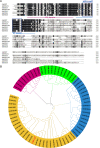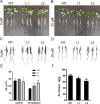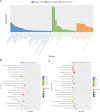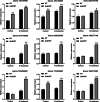GsMYB7 encoding a R2R3-type MYB transcription factor enhances the tolerance to aluminum stress in soybean (Glycine max L.)
- PMID: 35869448
- PMCID: PMC9306046
- DOI: 10.1186/s12864-022-08744-w
GsMYB7 encoding a R2R3-type MYB transcription factor enhances the tolerance to aluminum stress in soybean (Glycine max L.)
Abstract
Background: MYB transcription factor (TF) is one of the largest families of TFs in plants and play essential roles in plant growth and development, and is involved in responses to biological and abiotic stress. However, there are few reports on GsMYB7 gene in soybean under aluminum acid stress, and its regulatory mechanism remains unclear.
Results: The GsMYB7 protein is localized in the nucleus and has transcriptional activation ability. Quantitative real-time PCR (qRT-PCR) results showed that GsMYB7 held a constitutive expression pattern rich in roots. When AlCl3 concentration was 25 µM, the total root surface area (SA) of GsMYB7 transgenic lines were 34.97% higher than that of wild-type Huachun 6 (HC6). While the accumulation of Al3+ in root tip of transgenic plants after aluminum treatment was 17.39% lower than that of wild-type. RNA-sequencing analysis indicated that over 1181 genes were regulated by GsMYB7 and aluminum stress. Among all the regulated genes, the expression levels of glutathione peroxidase, protein kinase, cytochrome and other genes in the transgenic lines were significantly higher than those in wild type by acidic aluminum stress. The bioinformatics and qRT-PCR results showed that 9 candidate genes were induced under the treatments of acidic aluminum stress which were indirectly and/or directly regulated by GsMYB7. After AlCl3 treatments, the transcripts of these genes in GsMYB7 transgenic seedlings were significantly higher than those of wide-type HC6.
Conclusions: The results suggested that GsMYB7 may enhance soybean tolerance to acidic aluminum stress by regulating the downstream genes.
Keywords: Acidic aluminum; GsMYB7; R2R3-MYB; Soybean; Transcription factor.
© 2022. The Author(s).
Conflict of interest statement
The authors declare that they have no competing interests.
Figures









Similar articles
-
GmMYB183, a R2R3-MYB Transcription Factor in Tamba Black Soybean (Glycine max. cv. Tamba), Conferred Aluminum Tolerance in Arabidopsis and Soybean.Biomolecules. 2024 Jun 19;14(6):724. doi: 10.3390/biom14060724. Biomolecules. 2024. PMID: 38927127 Free PMC article.
-
GsMYB10 encoding a MYB-CC transcription factor enhances the tolerance to acidic aluminum stress in soybean.BMC Plant Biol. 2024 Dec 26;24(1):1251. doi: 10.1186/s12870-024-06004-5. BMC Plant Biol. 2024. PMID: 39725892 Free PMC article.
-
Heterologous Expression of a Glycine soja C2H2 Zinc Finger Gene Improves Aluminum Tolerance in Arabidopsis.Int J Mol Sci. 2020 Apr 15;21(8):2754. doi: 10.3390/ijms21082754. Int J Mol Sci. 2020. PMID: 32326652 Free PMC article.
-
Diverse roles of MYB transcription factors in plants.J Integr Plant Biol. 2025 Mar;67(3):539-562. doi: 10.1111/jipb.13869. Epub 2025 Feb 27. J Integr Plant Biol. 2025. PMID: 40013511 Review.
-
The Role of Plant Transcription Factors in the Fight against Plant Viruses.Int J Mol Sci. 2023 May 8;24(9):8433. doi: 10.3390/ijms24098433. Int J Mol Sci. 2023. PMID: 37176135 Free PMC article. Review.
Cited by
-
GmABR1 encoding an ERF transcription factor enhances the tolerance to aluminum stress in Arabidopsis thaliana.Front Plant Sci. 2023 Mar 23;14:1125245. doi: 10.3389/fpls.2023.1125245. eCollection 2023. Front Plant Sci. 2023. PMID: 37035040 Free PMC article.
-
GmMYB183, a R2R3-MYB Transcription Factor in Tamba Black Soybean (Glycine max. cv. Tamba), Conferred Aluminum Tolerance in Arabidopsis and Soybean.Biomolecules. 2024 Jun 19;14(6):724. doi: 10.3390/biom14060724. Biomolecules. 2024. PMID: 38927127 Free PMC article.
-
An Oxalate Transporter Gene, AtOT, Enhances Aluminum Tolerance in Arabidopsis thaliana by Regulating Oxalate Efflux.Int J Mol Sci. 2023 Feb 24;24(5):4516. doi: 10.3390/ijms24054516. Int J Mol Sci. 2023. PMID: 36901947 Free PMC article.
-
Identification and Functional Characterization of WRKY, PHD and MYB Three Salt Stress Responsive Gene Families in Mungbean (Vigna radiata L.).Genes (Basel). 2023 Feb 10;14(2):463. doi: 10.3390/genes14020463. Genes (Basel). 2023. PMID: 36833390 Free PMC article.
-
GsMYB10 encoding a MYB-CC transcription factor enhances the tolerance to acidic aluminum stress in soybean.BMC Plant Biol. 2024 Dec 26;24(1):1251. doi: 10.1186/s12870-024-06004-5. BMC Plant Biol. 2024. PMID: 39725892 Free PMC article.
References
MeSH terms
Substances
Grants and funding
- CARS-04-PS09/the China Agricultural Research System
- 4100-C17106, 21301091702101/Ministry of Agriculture and Rural Affairs agricultural products quality and safety supervision special
- 2020B020220008/the Projects of Key Area Research and Development Program of Guangdong Province
- NZ2021012/the project of the Guangdong Provincial Laboratory of Lingnan Modern Agricultural Science and Technology
- 4100-31331/the Research Project of the State Key Laboratory of Agricultural and Biological Resources Protection and Utilization in Subtropics
LinkOut - more resources
Full Text Sources
Miscellaneous

